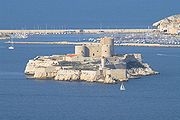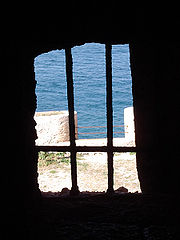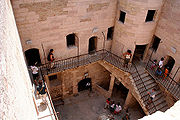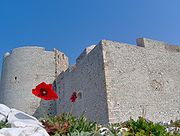
Château d'If
Encyclopedia



Frioul archipelago
The Frioul archipelago is a group of 4 islands located off the Mediterranean coast of France, approximately at 4 km from Marseille. The islands of the archipelago cover a total land area of approximately 200 hectares....
situated in the Mediterranean Sea
Mediterranean Sea
The Mediterranean Sea is a sea connected to the Atlantic Ocean surrounded by the Mediterranean region and almost completely enclosed by land: on the north by Anatolia and Europe, on the south by North Africa, and on the east by the Levant...
about a mile offshore in the Bay of Marseille
Marseille
Marseille , known in antiquity as Massalia , is the second largest city in France, after Paris, with a population of 852,395 within its administrative limits on a land area of . The urban area of Marseille extends beyond the city limits with a population of over 1,420,000 on an area of...
in southeastern France. It is famous for being one of the settings of Alexandre Dumas'
Alexandre Dumas, père
Alexandre Dumas, , born Dumas Davy de la Pailleterie was a French writer, best known for his historical novels of high adventure which have made him one of the most widely read French authors in the world...
adventure novel The Count of Monte Cristo
The Count of Monte Cristo
The Count of Monte Cristo is an adventure novel by Alexandre Dumas. It is often considered to be, along with The Three Musketeers, Dumas's most popular work. He completed the work in 1844...
.
The château
Château
A château is a manor house or residence of the lord of the manor or a country house of nobility or gentry, with or without fortifications, originally—and still most frequently—in French-speaking regions...
is a square, three-story building 28 m long on each side, flanked by three towers with large gun embrasure
Embrasure
In military architecture, an embrasure is the opening in a crenellation or battlement between the two raised solid portions or merlons, sometimes called a crenel or crenelle...
s. The remainder of the island, which only measures 30,000 square metres, is heavily fortified; high ramparts with gun platforms surmount the island's cliffs.
Fortress
The château was built in 1524-31 on the orders of King Francis IFrancis I of France
Francis I was King of France from 1515 until his death. During his reign, huge cultural changes took place in France and he has been called France's original Renaissance monarch...
as a defence against attacks from the sea. However, its construction was extremely controversial. When Marseille was annexed to France in 1481, it retained the right to provide for its own defence. The castle was therefore seen by many of the local inhabitants as an unwanted imposition of central authority.
The castle's principal military value was as a deterrent; it never had to fight off an actual attack. The closest that it came to a genuine test of strength was in July 1531, when the Holy Roman Emperor
Holy Roman Emperor
The Holy Roman Emperor is a term used by historians to denote a medieval ruler who, as German King, had also received the title of "Emperor of the Romans" from the Pope...
Charles V
Charles V, Holy Roman Emperor
Charles V was ruler of the Holy Roman Empire from 1519 and, as Charles I, of the Spanish Empire from 1516 until his voluntary retirement and abdication in favor of his younger brother Ferdinand I and his son Philip II in 1556.As...
made preparations to attack Marseille. However, he abandoned the invasion plan, perhaps deterred by the presence of the castle.
This was perhaps fortunate, given the weaknesses identified by the military engineer Vauban
Vauban
Sébastien Le Prestre, Seigneur de Vauban and later Marquis de Vauban , commonly referred to as Vauban, was a Marshal of France and the foremost military engineer of his age, famed for his skill in both designing fortifications and breaking through them...
in a scathing report in 1701: "The fortifications look like the rock, they are fully rendered, but very roughly and carelessly, with many imperfections. The whole having been very badly built and with little care... All the buildings, very crudely done, are ill made."
After his assassination in Cairo
Cairo
Cairo , is the capital of Egypt and the largest city in the Arab world and Africa, and the 16th largest metropolitan area in the world. Nicknamed "The City of a Thousand Minarets" for its preponderance of Islamic architecture, Cairo has long been a centre of the region's political and cultural life...
in 1800, the embalmed body of general Jean Baptiste Kléber
Jean Baptiste Kléber
Jean Baptiste Kléber was a French general during the French Revolutionary Wars. His military career started in Habsburg service, but his plebeian ancestry hindered his opportunities...
was repatriated to France. Napoleon
Napoleon I of France
Napoleon Bonaparte was a French military and political leader during the latter stages of the French Revolution.As Napoleon I, he was Emperor of the French from 1804 to 1815...
, fearing his tomb would become a symbol to Republicanism, ordered it to stay at the château. It remained there for 18 years until Louis XVIII
Louis XVIII of France
Louis XVIII , known as "the Unavoidable", was King of France and of Navarre from 1814 to 1824, omitting the Hundred Days in 1815...
granted a proper burial in his native Strasbourg
Strasbourg
Strasbourg is the capital and principal city of the Alsace region in eastern France and is the official seat of the European Parliament. Located close to the border with Germany, it is the capital of the Bas-Rhin département. The city and the region of Alsace are historically German-speaking,...
.
Prison
The isolated location and dangerous offshore currents of the Château d'If made it an ideal escape-proof prisonPrison
A prison is a place in which people are physically confined and, usually, deprived of a range of personal freedoms. Imprisonment or incarceration is a legal penalty that may be imposed by the state for the commission of a crime...
, very much like the island of Alcatraz
Alcatraz Island
Alcatraz Island is an island located in the San Francisco Bay, offshore from San Francisco, California, United States. Often referred to as "The Rock" or simply "Traz", the small island was developed with facilities for a lighthouse, a military fortification, a military prison, and a Federal...
in California
California
California is a state located on the West Coast of the United States. It is by far the most populous U.S. state, and the third-largest by land area...
was in more modern times. Its use as a dumping ground for political and religious detainees soon made it one of the most feared and notorious jails in France. Over 3,500 Huguenot
Huguenot
The Huguenots were members of the Protestant Reformed Church of France during the 16th and 17th centuries. Since the 17th century, people who formerly would have been called Huguenots have instead simply been called French Protestants, a title suggested by their German co-religionists, the...
s (French Protestants) were sent to If, as was Gaston Crémieux, a leader of the Paris Commune
Paris Commune
The Paris Commune was a government that briefly ruled Paris from March 18 to May 28, 1871. It existed before the split between anarchists and Marxists had taken place, and it is hailed by both groups as the first assumption of power by the working class during the Industrial Revolution...
, who was shot there in 1871.
The island became internationally famous in the 19th century when Alexandre Dumas used it as a setting for The Count of Monte Cristo
The Count of Monte Cristo
The Count of Monte Cristo is an adventure novel by Alexandre Dumas. It is often considered to be, along with The Three Musketeers, Dumas's most popular work. He completed the work in 1844...
, published to widespread acclaim in 1844. In the book, the main character Edmond Dantès
Edmond Dantès
Edmond Dantès is the protagonist and title character of Alexandre Dumas, père's novel, The Count of Monte Cristo.Dumas may have gotten the idea for the character of Edmond from a story which he found in a book compiled by Jacques Peuchet, archivist to the French police. Peuchet related the tale of...
(a commoner who later purchases the noble title of Count) and his mentor, Abbé Faria
Abbé Faria
Abbé Faria , or Abbé José Custódio de Faria, , was a colourful Goan Catholic monk who was one of the pioneers of the scientific study of hypnotism, following on from the work of Franz Anton Mesmer...
, were both imprisoned in it. After fourteen years, Dantès makes a daring escape from the castle, becoming the first person ever to do so and survive. In reality, no one is known to have done this. The modern Château d'If maintains adjacent cells named after Dantès and Faria as a tourist attraction.
As was common practice in those days, prisoners were treated differently according to their class and wealth. The poorest were literally placed at the bottom, being confined to a windowless dungeon under the castle. The wealthiest were much better off, living comparatively comfortably in their own private cells (or pistoles) higher up, with windows, a garderobe
Garderobe
The term garderobe describes a place where clothes and other items are stored, and also a medieval toilet. In European public places, a garderobe denotes the cloakroom, wardrobe, alcove or an armoire. In Danish, Dutch, German and Spanish garderobe can mean a cloakroom. In Latvian it means checkroom...
and a fireplace
Fireplace
A fireplace is an architectural structure to contain a fire for heating and, especially historically, for cooking. A fire is contained in a firebox or firepit; a chimney or other flue allows gas and particulate exhaust to escape...
. However, they were expected to pay for this privilege, effectively forcing them to fund their own incarceration
Incarceration
Incarceration is the detention of a person in prison, typically as punishment for a crime .People are most commonly incarcerated upon suspicion or conviction of committing a crime, and different jurisdictions have differing laws governing the function of incarceration within a larger system of...
.
The château today

Mark Twain
Mark Twain
Samuel Langhorne Clemens , better known by his pen name Mark Twain, was an American author and humorist...
visited the château in July, 1867 during a months long pleasure excursion. He recounts his visit in his book, The Innocents Abroad. He says a guide took his party into the prison, inside cells, and showed him the cell in which housed the "Iron Mask." This was prior to the château opening to the public. There is a sign at the château that says "Prison dite de l'Homme au Masque de Fer." This is likely only legend since the Man in the Iron Mask
Man in the Iron Mask
The Man in the Iron Mask is a name given to a prisoner arrested as Eustache Dauger in 1669 or 1670, and held in a number of jails, including the Bastille and the Fortress of Pignerol . He was held in the custody of the same jailer, Bénigne Dauvergne de Saint-Mars, for a period of 34 years...
was never held at the Chateau d'If.
The Château d'If is listed as a monument historique
Monument historique
A monument historique is a National Heritage Site of France. It also refers to a state procedure in France by which national heritage protection is extended to a building or a specific part of a building, a collection of buildings, or gardens, bridges, and other structures, because of their...
by the French Ministry of Culture.

In fictional works
In the "Tales of Old Dartmoor" episode (recorded in 1956) of The Goon ShowThe Goon Show
The Goon Show was a British radio comedy programme, originally produced and broadcast by the BBC Home Service from 1951 to 1960, with occasional repeats on the BBC Light Programme...
radio comedy series, Grytpype-Thynne
Hercules Grytpype-Thynne
Hercules Grytpype-Thynne was a character from the British 1950s comedy radio programme The Goon Show. He was voiced by Peter Sellers. In the episode "Who Is Pink Oboe?", Valentine Dyall filled-in for the role in Sellers' absence....
arranges for Dartmoor Prison
Dartmoor (HM Prison)
HM Prison Dartmoor is a Category C men's prison, located in Princetown, high on Dartmoor in the English county of Devon. Its high granite walls dominate this area of the moor...
to put to sea to visit the Château d'If as part of a plan to find the treasure of the Count of Monte Cristo hidden there.
The fortress was used as the location where Alain Charnier a.k.a Frog One (Fernando Rey
Fernando Rey
Fernando Casado Arambillet , best known as Fernando Rey, was a Spanish film, theatre, and TV actor, who worked in both Europe and the United States...
) meets Devereaux (Frédéric de Pasquale
Frédéric de Pasquale
Frédéric de Pasquale was a French actor. He appeared in 50 films and television shows between 1960 and 2001.-Selected filmography:* Children of Mata Hari * The French Connection...
) to finalise the drugs shipment to the United States in the 1971 crime film The French Connection
The French Connection (film)
This article is about the 1971 film. For the British fashion label, see French Connection .The French Connection is a 1971 American crime film directed by William Friedkin. The film was adapted and fictionalized by Ernest Tidyman from the non-fiction book by Robin Moore...
.
However other locations have been used for Château d'If in the retelling of Dumas' The Count of Monte Cristo
The Count of Monte Cristo
The Count of Monte Cristo is an adventure novel by Alexandre Dumas. It is often considered to be, along with The Three Musketeers, Dumas's most popular work. He completed the work in 1844...
. In the 2002 adaptation
The Count of Monte Cristo (2002 film)
The Count of Monte Cristo is a 2002 adventure film directed by Kevin Reynolds. The film is the tenth adaptation of the book of the same name by Alexandre Dumas, père and stars Richard Harris, James Caviezel, Dagmara Dominczyk, Guy Pearce, and Luis Guzman...
starring Jim Caviezel, the château was represented by St. Mary's Tower
St. Mary's Tower
St. Mary's Tower is a fortification on the island of Comino in the Malta archipelago. One can see it easily from the ferry that crosses from Malta to Gozo.-Origins:...
on Comino
Comino
Comino is an island of the Maltese archipelago between the islands of Malta and Gozo in the Mediterranean Sea, measuring in area. Named after the cumin seed that once flourished in the Maltese islands, Comino is noted for its tranquility and isolation. It has a permanent population of only four...
, the smallest Maltese
Malta
Malta , officially known as the Republic of Malta , is a Southern European country consisting of an archipelago situated in the centre of the Mediterranean, south of Sicily, east of Tunisia and north of Libya, with Gibraltar to the west and Alexandria to the east.Malta covers just over in...
island. The cliff-top watchtower can be seen from the ferry crossing between Malta and Gozo.
It is also used in the Clive Cussler
Clive Cussler
Clive Eric Cussler is an American adventure novelist and marine archaeologist. His thriller novels, many featuring the character Dirk Pitt, have reached The New York Times fiction best-seller list more than seventeen times...
book Spartan Gold as a hiding place for artifacts.
Notable prisoners
- Chevalier Anselme (1580-?)
- Jean Serres, Huguenot
- Élie Neau, Huguenot
- Chevalier de LorraineChevalier de LorrainePhilippe of Lorraine, called the Chevalier de Lorraine was a French noble man and member of the House of Guise, cadet of the Ducal house of Lorraine. He was the renowned lover of Philippe de France, Monsieur, brother of Louis XIV.-Biography:Philippe de Lorraine was the second son of the Count and...
, lover of Philippe de FrancePhilippe I, Duke of OrléansPhilippe of France was the youngest son of Louis XIII of France and his queen consort Anne of Austria. His older brother was the famous Louis XIV, le roi soleil. Styled Duke of Anjou from birth, Philippe became Duke of Orléans upon the death of his uncle Gaston, Duke of Orléans... - Jean-Baptiste Chataud, accused of bringing the plagueBubonic plaguePlague is a deadly infectious disease that is caused by the enterobacteria Yersinia pestis, named after the French-Swiss bacteriologist Alexandre Yersin. Primarily carried by rodents and spread to humans via fleas, the disease is notorious throughout history, due to the unrivaled scale of death...
to Marseille - (c.1720 - c.1723) - Honoré Mirabeau, writer, popular orator and statesman - (1774–1775)
- Abbé FariaAbbé FariaAbbé Faria , or Abbé José Custódio de Faria, , was a colourful Goan Catholic monk who was one of the pioneers of the scientific study of hypnotism, following on from the work of Franz Anton Mesmer...
- (1797-?) - his stay at the château is disputed - Michel Mathieu Lecointe-PuyraveauMichel Mathieu Lecointe-PuyraveauMichel Mathieu Lecointe-Puyraveau was a French politician.-Assembly and Convention:Born in Saint-Maixent-l'École , he was elected deputy for his département to the Legislative Assembly in 1792, where he made himself known for his harsh stances against the moderates...
, politician - (1815) - Gaston Crémieux, a leader of the Paris CommuneParis CommuneThe Paris Commune was a government that briefly ruled Paris from March 18 to May 28, 1871. It existed before the split between anarchists and Marxists had taken place, and it is hailed by both groups as the first assumption of power by the working class during the Industrial Revolution...
(1871) - Edmond DantèsEdmond DantèsEdmond Dantès is the protagonist and title character of Alexandre Dumas, père's novel, The Count of Monte Cristo.Dumas may have gotten the idea for the character of Edmond from a story which he found in a book compiled by Jacques Peuchet, archivist to the French police. Peuchet related the tale of...
, the fictional Count of Monte Cristo in the eponymous novel by Alexandre Dumas, pèreAlexandre Dumas, pèreAlexandre Dumas, , born Dumas Davy de la Pailleterie was a French writer, best known for his historical novels of high adventure which have made him one of the most widely read French authors in the world...
(February 28, 1815 - February 28, 1829 in the book).
Contrary to common belief, The Man in the Iron Mask and Marquis de Sade
Marquis de Sade
Donatien Alphonse François, Marquis de Sade was a French aristocrat, revolutionary politician, philosopher, and writer famous for his libertine sexuality and lifestyle...
were not prisoners at the château.

